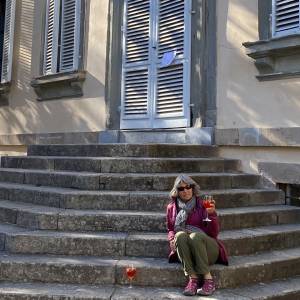Lake of the Gods and Emperors
Staying in Spello is like being on a stationary bike tour. Each day we travel along a different spoke of the Umbrian wheel, coming back to our home hub at the end of the day to shower, cook dinner and sleep in a familiar bed. The benefits are many. We are not loaded down with full panniers carrying all our belongings, and instead of superficially experiencing a place as we ride through on our way to a final destination, we get to go somewhere and explore it more deeply.
Today’s route was almost exclusively along designated bike paths, to our great relief! Our destination was Pissignano Castle and the“Fonti del Clitumno”(featured). The Fountains of Clitunno are actually freshwater springs that fill a small lake before originating the Clitunno River. It costs 3 euro to enter the idyllic mini park where you can walk around the crystal clear lake, sit on a bench in the tree dappled shade, and watch the ducks and swans. Feeding the birds costs extra, picnics are forbidden, you can’t touch the water, and there are no restrooms. You have to walk to the adjacent free public park to use the loo. The freebie park has shade and benches but the lake and soothing greenery are on the other side of a cyclone fence. Underwhelmed by the modern day Fonti del Clitumno, we tried to imagine when this place was truly an idyllic expansive park without fences, restaurants and a busy road with cars and buses. Sacred to the Ancient Romans, this place takes its name from the river god Clitunno, and just down the road we visited the mostly intact, christianized Temple of Clitunno. It also costs 3 euros to enter and look at the front of the temple. You can see the back of the temple from the road for free. Interesting, but underwhelming. Yet back in the day it was indeed idyllic. Emperors Octavio Augustus and Caligula came here to enjoy the waters. Pliny the Younger and Virgil praised the water’s qualities. Lord Byron and others wrote poetry about Clitunno. We ate our lunch along a stretch of the crystal clear spring-fed creek between the Temple and the Fonti. We sat at a tree shaded picnic table, cooled our hands in the water, and watched a red beaked Moorhen fishing for food. All for free.
Pissignano Castle is across the street and halfway up the mountain. We locked our bikes at the very small central piazza of the very small town of Pissignano. I swapped my cleated cycling shoes for sneakers and up we went. Pissignano is derived from term “piscina di Giano” (the god Janus’ swimming pool), which is a name the Romans gave to the lake below formed by the Fonti del Clitumno springs. Pissignano Castle has a long history involving 10th century Benedictine monks, 11th century skirmishes with neighboring Spoleto and Trevi, 13th century takeover by Frederick II, 14th century visits by St. Francis, 15th century palace built by the Trinci family, and then it was an autonomous town until the 19th century. Eventually the town was totally abandoned and empty until the mid-70’s when an artist from Venice decided to resurrect the pile of ruins to create an independently funded artist commune. Antonio Meneghetti died in 2013, but the artist colony of Lizori lives on. It is an odd little place. The Palazzo/Castle is only open on Sundays so we only walked around the ‘stone condominiums’ of Lizori (extra) the refurbished hamlet adjacent to Pissignano Castle. The other extras is The 13th century octagonal lookout tower of Pissignano Castle’s, probably built at the request of Frederick II, as he had a penchant for octagonal buildings.
- 1
- 0
- Apple iPhone 14 Pro
- 1/1000
- f/1.8
- 7mm
- 64

Comments
Sign in or get an account to comment.


